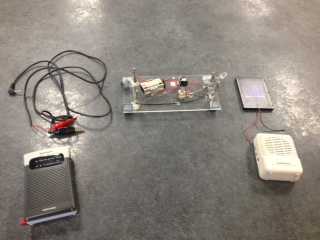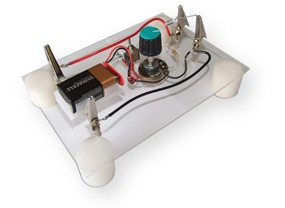Final Project Development
The assignment this week (and for the remaining weeks is to plan and document a final project that "integrates the range of units covered. To do so I'll need to answer a number of questions laid out by Dr. Gershenfeld:
What will it do?
My original project idea centered around making a motorized cart that could follow some sort of input directions and move for an appropriate amount of time or distance. While I have gotten away from that idea, the motivation behind it was something that I could use in my physics classroom to help my students better understand a concept. What I have now decided is to fab together one of the labs that we used to do within the Physics curriculum. The lab that I have chosen used to be part of our Electromagnetic Waves/Energy Unit. I keeping using the phrasing "used to" because we simply do not have the funds to keep a classroom set of labs in good working shape. We shared this particular lab with another school district and the travel, and wear and tear that use by high school students will put on equipment was really starting to show so we weeded it out of our curriculum, much to the detriment of our students in my opinion. As such, I thought this would be the perfect opportunity for fab lab to come to the rescue. I could make our own set of labs, fit to our specifications, and hopefully increase their durability enough. If nothing else, hopefully I could make a simple, cheap version of the lab so that if it did lack durability, it was easy enough to just make another one.
As I mentioned, the lab is part of our electromagnetic energy unit. The lab consists of a few pieces: a speaker or radio, a circuit that changes the incoming energy into IR or visible light, a solar cell, and an amplifier that can then retransmit the sound. Basically the students are making rudimentary cell phones. They take a sound wave, turn it into am EM wave, transmit it across a distance, and then turn it back into a sound wave. Here's the set up that we use:

This set up barely works. Loose connections, old parts, and general time have made it into one of those labs where you pray that you hold it just right and stand on one leg and don't breathe, that maybe you'll hear some fuzz come out of the amplifier on the other end (let alone actual music).
So to finally answer the question, it is my hope that my final project will convert an audio signal (weather from a speaker or a cable) into either an IR or visible light wave in a LED and that that signal will then be picked up by a solar cell and transmitted back to audio through an amplifier. I will also build a case for all of this so that it will have some longevity.
Who's done what before hand?
Because this project is revamping an already existing lab, it has been mas-produced before in some form. While our circuit has no labeling or markings, a quick google search led me to the Arbor Scientific site that has a purchasable version that looks pretty similar to ours.

What materials and components will be required?
There are two basic components, each of which will need to be housed in some sort of case. In the transmitter circuit, I will need an Infrared Light Emitting Diode, a capacitor, a battery, an audio cable with 1/8" mini-plug, and the board itself to hold all this. In the receiver circuit, I will need a solar cell, and an amplifier or speaker (can I fab my own?). I will also build a case for each circuit, hopefully with snap fit materials from the laser cutter.
Where will they come from?
As a only teacher and participant in the fab academy here at SHS, I'd be hard pressed to say exactly what is in the fab "inventory." I'll start my search there. After that, I'll probably head to Digi Key for any of the remaining circuitry parts. For the cases, I'll have to check what we have at school, but I do want it to be durable enough to last.
How much will it cost?
Great question. I've never built any circuitry except when taking directly from the inventory so I'm not sure. I think circuitry parts are pretty cheap right? We have a limit of $50 to spend, so it’s gotta be cheaper than that :)
What parts and systems will be made?
I'd like to try to make everything except the initial audio input (mp3 player, or mic for students voice... i guess I could make a mic maybe?). That means I'll need to make the transmitter circuit that has the audio input, LED, capacitor, and battery; the receiver circuit which has the solar cell connected to a speaker amplifier (that I'll try to make)
What processes will be used?
I assume this question means how will I make all this stuff? Since it is circuitry based, a lot will be done on the milling machine. The cases I had thought about using the laser cutter, but there are parts I could 3-D print as well. In the interest of making a full class set one day, perhaps I’ll mold the cases so that I can easily mass produce them. I’ll also use the vinyl cutter for some labeling.
What tasks need to be completed?
1. Order parts. I ordered some capacitors, LEDs, and cables, and we’ll see what else I need.
2. Figure how to make some of this stuff.
3. Make it.
4. Design cases.
5. Make em.
What questions need to be answered?
A ton.
1. How do I hook the audio into the circuit board?
2. How do I connect the audio input to the led?
3. How do I connect the solar cell to the speaker/amplifier?
4. How do I make a speaker/amplifier?
a. Will the hello speaker from fab academy work?
What is the schedule?
Wait for parts, hopefully have some of those questions answered before they get here. Make boards first, so I know how big to make cases.
How will it be evaluated?
Can I get an audio signal through my circuit and out the other side? That’s a great first step. Do the cases hold the parts together in a durable fashion. That’d be a success too.